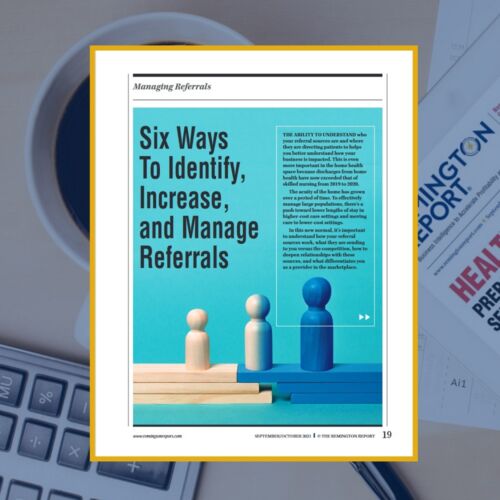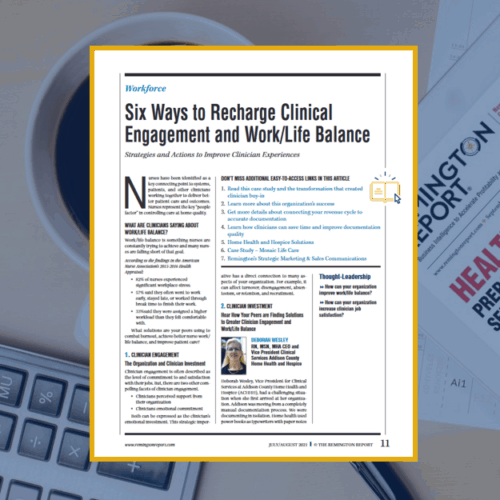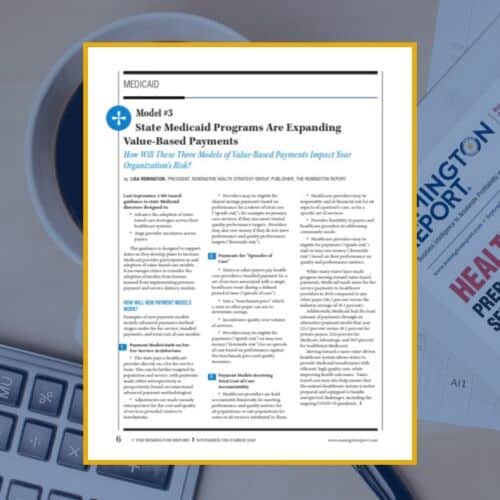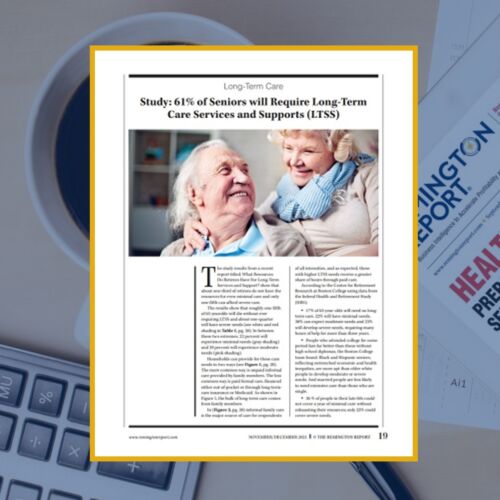-
 Your referral partners increasingly expect robust communications to make patient transfers as seamless as possible, for both the patient and providers. They will have to make a choice. Ultimately, they will look for relationships with organizations that are easy to work with and that can deliver proven quality care. We provide insights and strategies from high-performing organizations. This article is free to 1-Year Classic and 2-Year Premium subscribers.
Your referral partners increasingly expect robust communications to make patient transfers as seamless as possible, for both the patient and providers. They will have to make a choice. Ultimately, they will look for relationships with organizations that are easy to work with and that can deliver proven quality care. We provide insights and strategies from high-performing organizations. This article is free to 1-Year Classic and 2-Year Premium subscribers. -
 In this new normal, it’s important to understand how your referral sources work, what they are sending to you versus the competition, how to deepen relationships with these sources, and what differentiates you as a provider in the marketplace. This article is free to 1-Year Classic and 2-Year Premium subscribers.
In this new normal, it’s important to understand how your referral sources work, what they are sending to you versus the competition, how to deepen relationships with these sources, and what differentiates you as a provider in the marketplace. This article is free to 1-Year Classic and 2-Year Premium subscribers. -
 Strategies and actions to improve clinician experiences. Work/life balance is something nurses are constantly trying to achieve, and many nurses are falling short of that goal. What solutions are your peers using to combat burnout, achieve better nurse work/life balance, and improve patient care? This article is free to 1-Year Classic and 2-Year Premium subscribers.
Strategies and actions to improve clinician experiences. Work/life balance is something nurses are constantly trying to achieve, and many nurses are falling short of that goal. What solutions are your peers using to combat burnout, achieve better nurse work/life balance, and improve patient care? This article is free to 1-Year Classic and 2-Year Premium subscribers. -
 Building Stronger Referral Partnerships with Tools, Trends, and Powerful Insights About the Changing Paradigm This online series includes two master classes that are designed to identify opportunities for relationship building, craft compelling value propositions, and offer guidance to better understand quality measures, screening tools, the impact on each of your referral partners, and how you can become a high-engaged partner. REGISTRATION FEE: $800 (Includes 2 Webinars) AVAILABLE ON-DEMAND Registration includes all three webinars, with enrollment for up to 10 people. Must be enrolled to attend. Business email required for each enrollee.
Building Stronger Referral Partnerships with Tools, Trends, and Powerful Insights About the Changing Paradigm This online series includes two master classes that are designed to identify opportunities for relationship building, craft compelling value propositions, and offer guidance to better understand quality measures, screening tools, the impact on each of your referral partners, and how you can become a high-engaged partner. REGISTRATION FEE: $800 (Includes 2 Webinars) AVAILABLE ON-DEMAND Registration includes all three webinars, with enrollment for up to 10 people. Must be enrolled to attend. Business email required for each enrollee.Add Your Enrollees
Additional enrollees will be enabled upon completion of registration. Company email addresses required. Think Tank programs are open only to provider organizations delivering patient care, including home health care, at-home care, hospice, palliative care, community-based organizations, hospitals, ACOs, managed care organizations, and physicians. Enrollees for the program must be full-time employees of the organization. If you are unsure whether your organization qualifies for Think Tank programs or your organization is a provider that also sells products, services or you are a consultant, then contact us before enrolling. -
 This series provides multi-level staffing solutions to today’s workforce challenges, offering proven, time-tested guidance from a CEO veteran with 30 years of experience in home-based care. A home-based care organization’s greatest asset are clinicians, staff, and managers. How can your organization reduce clinician burnout, improve productivity, create adaptive staffing models, and promote a culture of clinician engagement to increase retention? A powerful webinar series that will help you tackle staffing issues.
This series provides multi-level staffing solutions to today’s workforce challenges, offering proven, time-tested guidance from a CEO veteran with 30 years of experience in home-based care. A home-based care organization’s greatest asset are clinicians, staff, and managers. How can your organization reduce clinician burnout, improve productivity, create adaptive staffing models, and promote a culture of clinician engagement to increase retention? A powerful webinar series that will help you tackle staffing issues.- Webinar #1: Adaptive Staffing Models by Clinical Conditions to Improve Patient Outcomes, Efficiency, and Organizational Capacity
- Webinar #2: Multidisciplinary Team Staffing Models to Improve Retention, Productivity, and Continuity of Care
- Webinar #3: Staffing Strategies for Chronic Care Management to Improve Outcomes
Add Your Enrollees
Additional enrollees will be enabled upon completion of initial enrollee. Company email addresses required. Think Tank programs are open only to provider organizations delivering patient care, including home health care, at-home care, hospice, palliative care, community-based organizations, hospitals, ACOs, managed care organizations, and physicians. Enrollees for the program must be full-time employees of the organization. If you are unsure whether your organization qualifies for Think Tank programs or your organization is a provider that also sells products, services or you are a consultant then contact us before enrolling. -
 Telehealth is predicted to be the next big investment for seniors aging in place. The number of seniors requiring additional caregiving and support due to chronic disease will increase from about 14 percent of the senior population in 2010 to 21 percent by 2050, putting the pressure on healthcare providers to improve caregiving platforms. This article is free to 1-Year Classic and 2-Year Premium subscribers.
Telehealth is predicted to be the next big investment for seniors aging in place. The number of seniors requiring additional caregiving and support due to chronic disease will increase from about 14 percent of the senior population in 2010 to 21 percent by 2050, putting the pressure on healthcare providers to improve caregiving platforms. This article is free to 1-Year Classic and 2-Year Premium subscribers. -
 Examine the latest strategies with a focus on focus on care delivery improvement: care transitions, readmission management, care management, and outcomes. You’ll learn how to bridge the silos and develop a culture of trust by aligning the goals and incentives of all stakeholders within healthcare, including ACOs, hospitals/health systems, payers, physicians, and insurers. Tap into fresh thinking to inspire new levels of care delivery improvement. 4-MONTH PROGRAM Registration Open – INCLUDES 4 WEBINARS $1,650 SINGLE FEE INCLUDES 4 ENROLLEES This is an on-demand program.
Examine the latest strategies with a focus on focus on care delivery improvement: care transitions, readmission management, care management, and outcomes. You’ll learn how to bridge the silos and develop a culture of trust by aligning the goals and incentives of all stakeholders within healthcare, including ACOs, hospitals/health systems, payers, physicians, and insurers. Tap into fresh thinking to inspire new levels of care delivery improvement. 4-MONTH PROGRAM Registration Open – INCLUDES 4 WEBINARS $1,650 SINGLE FEE INCLUDES 4 ENROLLEES This is an on-demand program.Add Your Enrollees
Additional enrollees will be enabled upon completion of initial enrollee. Company email addresses required. -
 Physicians and Home Care Providers: Outcome-Based Relationships to Grow Referrals In this strategy workshop, you will learn 10 solutions for forging outcome-based relationships and ways to build deeper relationships with physicians. Fees
Physicians and Home Care Providers: Outcome-Based Relationships to Grow Referrals In this strategy workshop, you will learn 10 solutions for forging outcome-based relationships and ways to build deeper relationships with physicians. Fees- $412.50
- Purchase both workshops and save 10%: Use coupon code STRATEGYWS at checkout
- Registration includes enrollment for up to 10 people. Must be enrolled to attend. Business email required for each enrollee.
Add Your Enrollees
Additional enrollees will be enabled upon completion of registration. Company email addresses required. Think Tank programs are open only to provider organizations delivering patient care, including home health care, at-home care, hospice, palliative care, community-based organizations, hospitals, ACOs, managed care organizations, and physicians. Enrollees for the program must be full-time employees of the organization. If you are unsure whether your organization qualifies for Think Tank programs or your organization is a provider that also sells products, services or you are a consultant, then contact us before enrolling. -
 Specialists and Home Care Providers: Outcome-Based Relationships to Grow Referrals In this strategy workshop, you will learn 10 ways to enhance outcome-based relationships and ways to build deeper relationships with specialists. Fees
Specialists and Home Care Providers: Outcome-Based Relationships to Grow Referrals In this strategy workshop, you will learn 10 ways to enhance outcome-based relationships and ways to build deeper relationships with specialists. Fees- $412.50
- Purchase both workshops and save 10%: Use coupon code STRATEGYWS at checkout
Add Your Enrollees
Additional enrollees will be enabled upon completion of registration. Company email addresses required. Think Tank programs are open only to provider organizations delivering patient care, including home health care, at-home care, hospice, palliative care, community-based organizations, hospitals, ACOs, managed care organizations, and physicians. Enrollees for the program must be full-time employees of the organization. If you are unsure whether your organization qualifies for Think Tank programs or your organization is a provider that also sells products, services or you are a consultant, then contact us before enrolling. -
 Payers are interested in talking about the data. In particular, they are interested in understanding how home care providers are able to reduce their penalties and increase their rewards in a value-based payment system. Learn how one organization is advancing conversations. This article is free to 1-Year Classic and 2-Year Premium subscribers.
Payers are interested in talking about the data. In particular, they are interested in understanding how home care providers are able to reduce their penalties and increase their rewards in a value-based payment system. Learn how one organization is advancing conversations. This article is free to 1-Year Classic and 2-Year Premium subscribers.









